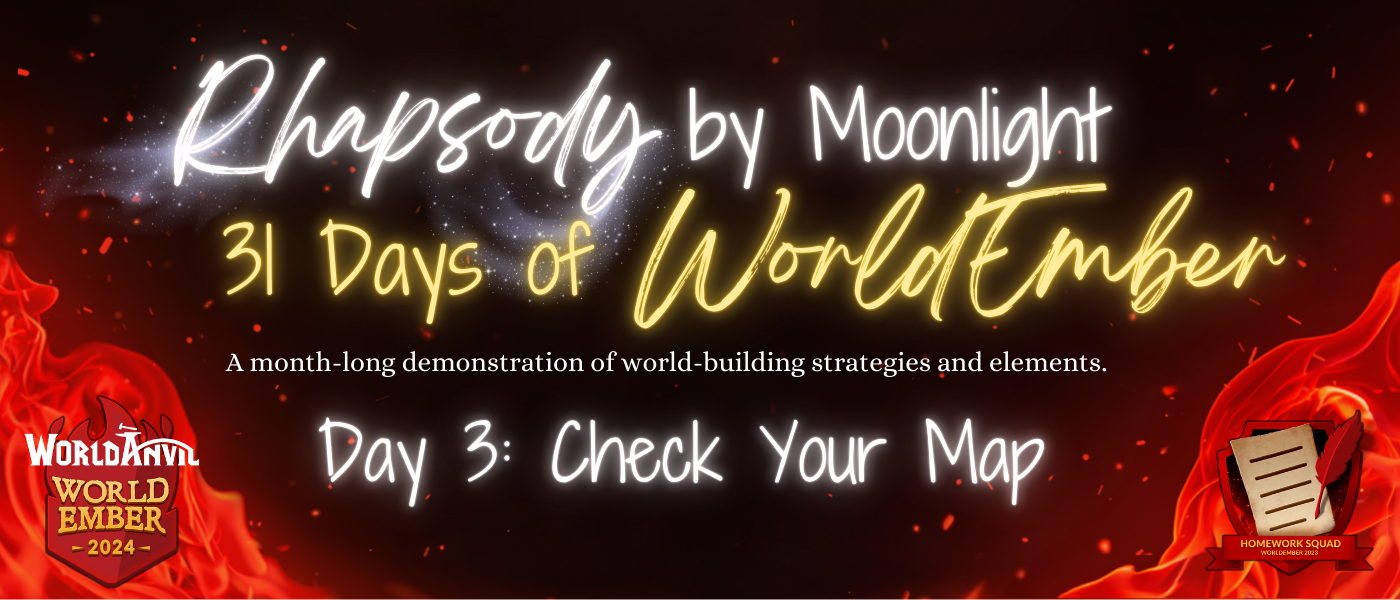Day 3: Check Your Map
Follow along with my WorldEmber progress!
I promised you a look over my shoulder this month as I bring a vague and disjointed collection of ideas together into a cohesive piece of world-building. These resources will help you keep track of my progress through this month-long marathon challenge:
- Haly’s Official WE Progress Report — each participant gets a page that automatically collects their author information and all WE-eligible articles across all worlds into a single, shareable package.
- A WorldEmber Chronicle — follow along with a map and timeline of my progress. You’ll see locations and information develop day-by-day as I work my way through the basic elements of world-building.
- Haly’s WorldEmber on Argentii Index — an on-the-fly journal page and handy sidebar displaying only new Argentii WE-eligible articles.
Why You Need a Map — Any Map! — of Your World
It’s day three of WorldAnvil’s annual WorldEmber challenge, and I’m going strong, even though I only wrote one Argentii article today. Still, it’s pretty crucial to the solo RPG as it’s where you first come into contact with Crossroads Island.
Before I could write it, however, I had to sit down and figure out where to go next! I’ve shopped my stubs, I’ve laid out the two big powerhouse nations. What did I need to do next? What would have the most impact for my current storytelling?
I was uncertain, so I decided to examine the map. In this case, it was literally a map of Crossroads Island that I created with Inkarnate Pro. Looking at it, I thought about the story I’m trying to tell. I looked at the beginning of the story, and chose that location as the next stop on my world-building journey: the North Docks.
Not All Maps Are Maps
If you have not already made a visual map of your world — whatever “world” is here, a city, a continent, a house, a solar system — then this is a good time to do so. Even if it’s as simple as a few shapes and names on a napkin. The sooner you can get a solid grasp on where things are in relation to each other, the better off you’ll be.
However, not all mapping has to be visual. That is, it doesn’t have to be a scaled drawing of the relationship between geographical features.
World Meta/World Bible
Another great way of mapping your world is with a meta document or world bible. You can see Argentii’s meta here for an example of what I mean. This should be a good look at what you’re tying to do, with some reminders of why you’re trying to do it. It’s a good idea to include some inspirational ideas, such as media, images, music, etc. The idea is to have a place to keep all of the Critical Core Ideas, the things that shouldn’t change much, frequently, or without consequence.
To-Do List
My particular form of dopamining does not involve checking off lists, but I know that for many people that is a sweet hit of happy brain juice. Listing is another excellent example of mapping your world. Build a to-do list out of related ideas as you write. For example, I now know I need to write about the North Dock Tower, as well as the North Dock Plaza.
Fluid World-building
World-building is, by its very nature, a fluid process. It flows and changes as you go along. It’s easy to dive too deep into rabbit holes of your own imagining, and difficult to wrangle all the information that’s trying to get out of your head, all at once.
Having a map — or several different kinds of maps! — is an important foundation to help you stay on track, focused, and productive. Especially if you’re trying to make serious progress on the growth of your world!
Deliberate World-building, Step-by-Step
Begin with what you know:
- Start with the things you’ve already written. Let those little stubs guide you toward a focus, look for places where they intersect, overlap, and piece together. (Dec. 2)
- Move on to the firm foundations, the things that you already know are set in stone. This might be a geographic feature, a character, a cultural touchstone (“known for their spicy food”), or any other hard, established facts about your world. (Dec. 2)
- Map the land and your ideas. It can be a loose sketch, a professional design, an outline, a thought web, a to-do list, or a WorldAnvil meta document.
Wrapping the Day
As I write this, I am sitting at 5,770 new words of world-building toward my 50,000 word goal.








Comments